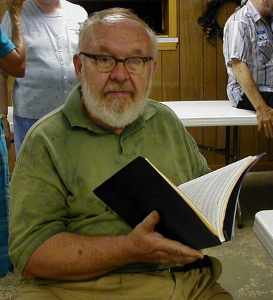EARLIEST KNOWN KILLOUGH
HISTORY

Professor Dean Mayhew - Aug. 2002

Professor Dean Mayhew - Aug. 2002
Professor Dean Mayhew of Rockland, Maine, has been researching the family beginnings for many years and is considered an authority in this area. He hired researchers in Ireland, Scotland and England for all the data possible and also for evidence of a Killough crest. No crest could be found. McKelleghs/Kelloughs operated under the crest of the Clan Donald. Following is a copy of a portion of a talk which Professor Mayhew gave at the annual Kalloch reunion, which my brother John and Barbara Killough and I attended in Rockland, ME, in 1992. Kalloch is the spelling primarily used by the Maine branch now. To keep the John Kelloughs apart, Mr. Mayhew arbitrarily named them John I, II, III, IV according to their generation.
Sir Thomas Phillips was a soldier of fortune in France in 1579-99. Many Scots were soldiers of fortune at this time. He came to Ulster [area of northern Ireland] from the French Service. For the next several years, he participated in campaigns in Leigh and Munster and, in 1601, raised a company of foot at Carrick-Fergus, County Antrim. This unit continued in service until April of 1605 when it shared the demobilization of the army in Ireland.
For his service in Ireland, Phillips received a 3,000 acre estate near Limavady in Kenoch Barony. As early as 1611, one John Kellough--John I--was listed on this estate as a servitor, equipped with a sword and pike. He is listed again in 1630 to ‘31. This is the only person in Ulster (northern Ireland) with any variant of the name at this time.
“Servitor” meant a person receiving land in exchange for military service. John was on the only major privately-owned estate in Ulster. Since he wasn’t on the Londoners’ holdings nor the Scottish undertakers’, he must have been under Phillips’ command, circa 1600. It was Phillips, not the overnment, which rewarded him. He might even have accompanied Phillips in the French wars. Where might John have originated?
Kerrick Fergus [city in northern Ireland] was barely across from Argyle, Scotland, in the Hebrides. Black, in his Surnames of Scotland, states that the name originates in Argyle, the original “McKellegh” from the island of South Uist in the Hebrides. South Uist was under the sway of the McDonalds of Clan Reynold. Hundreds of unemployed Clan Donald men swarmed into Ulster circa 1600 as “gallow classes,” or hired swords (read mercenaries) for the Irish noble. Scotland was simply a land of poverty and insecurity so we have John I at Limovady in 1631.
John II appears on the 1659 census at Drogheda in County Louth (pronounced Luth). Born in 1630, John II was not one of Cromwell’s troops, as the Protector did not send his regiments to Ireland until a bit later. Instead, numerous foot companies and regiments of heavy horse were raised locally and conducted the campaign until Cromwell’s arrival. Our John may thus have been in the army as early as 1647. Drogheda is the key here. From this siege comes the term, “Drogheda Quarter”. When the survivors came out to surrender, all were slaughtered. [by Cromwell’s troops]
Why would John II join the army? In the 1640s, a counter-revolution set in in Ulster. Hundreds of homes were destroyed and many were the victims of revenge murder, often at the hands of the woodkerns [armed Irish peasants] who lurked in the forest, bursting in upon and slaughtering the inhabitants at will. John I may have ended this way. If so, this would surely explain the horror of Drogheda by vengeance-seeking locally-raised troops.
After its fall, the town was garrisoned by several companies of foot, together with Jones and Coops regiments of heavy horse. Units gathered the land that they conquered. The troops grew crops to feed themselves and keep busy. In September of 1655, the army was simply marched out into the wilds and disbanded.
After 1655, most of Louth was set aside not only for the army but for the adventurers as well. Since the troops were Cromwell’s own, the government didn’t want to pay for it. The troops would be paid in Irish land, which only the officers wanted.
In 1654, John II had married Mary Hyde. By about 1660, John and Mary, with son John III, left for County Antrim (pronounced An-trim). He had probably sold his debenture to an officer to acquire cash for either land or a business in the new area. They probably established themselves at Antrim’s border in the Bann Valley. Here they would be close to their co-religionists [Scottish Presbyterian].
John III, born in Louth in 1657, married Anne McNeil and produced three children, Robert, John the Fourth and James. John III died at Antrim circa 1715. Robert and John IV and their sons came to America in 1718. James stayed in County Antrim.